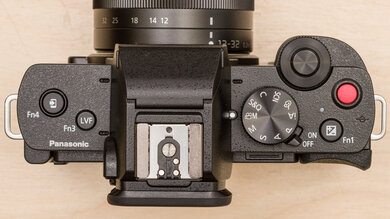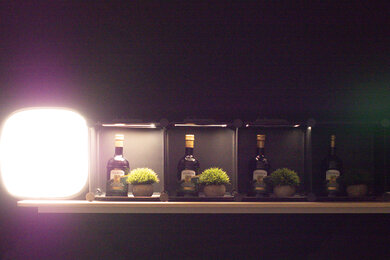The Panasonic LUMIX G100 is a mirrorless interchangeable lens camera with a Micro Four Thirds sensor. It's very lightweight and portable, and it comes equipped with a fully articulated touchscreen that makes it well-suited for vlogging. It delivers excellent JPEG image quality and fantastic 4k and FHD video quality in brighter lighting conditions. However, its RAW noise handling capability and low light video quality are noticeably worse due to its smaller sensor. Its autofocus system does a great job of tracking moving objects but struggles with faces. Battery performance is a bit disappointing, too, though this can vary with real-world conditions and settings. Unfortunately, it lacks in-body image stabilization and does a poor job of smoothing out camera shake. It's also not the most comfortable to use due to its small size and squared-off body, but on the upside, it has a very well laid-out menu system.
Our Verdict
The Panasonic LUMIX G100 is decent for travel photography. JPEG image quality is excellent, and it does a great job of tracking moving subjects for photography. It's also very small and lightweight, so it should fit easily into a travel bag to take with you on the go. However, its battery life is disappointing, and it does a poor job of stabilizing images without a tripod.
-
Good overall image quality for its class.
-
Small, lightweight design.
-
Autofocus effectively tracks moving objects.
-
Autofocus struggles to track moving faces.
-
Poor stabilization.
-
Disappointing battery life.
The Panasonic G100 is good for landscape photography. Image quality is good for its class, though it doesn't have the widest dynamic range to bring out more details in high-contrast landscape shots. Its RAW noise handling capability is just okay due to its smaller sensor. Still, it feels well-built, and it's very portable, making it easy to take with you to remote shooting locations, although people with larger hands may find it a bit uncomfortable to use.
-
Good overall image quality for its class.
-
Small, lightweight design.
-
Reasonably wide dynamic range.
-
Poor stabilization.
-
Disappointing battery life.
The Panasonic LUMIX G100 is sub-par for sport and wildlife photography. It delivers good overall image quality, though it isn't the best option for low light. Its autofocus system also struggles to track moving subjects. Its continuous shooting speed is also just okay, so it's not as well-suited to capturing quick bursts of fast action.
-
Good overall image quality for its class.
-
Small, lightweight design.
-
Autofocus effectively tracks moving objects.
-
Autofocus struggles to track moving faces.
-
Poor stabilization.
-
Disappointing battery life.
The Panasonic LUMIX G100 has satisfactory RAW image quality. It isn't the best low-light performer, with adequate noise management in trickier lighting conditions. It also has a fair amount of dynamic range, though you'll still lose detail in very high-contrast scenes. Thankfully, it resolves fine detail quite well, so images appear sharp even when punching in.
-
Reasonably wide dynamic range.
-
Noise handling in low light is just okay.
The Panasonic LUMIX G100 is good for vlogging. It's small and lightweight, so it's easy to take on the go. It also has a fully articulated screen so you can easily monitor yourself as you record. The video quality is good overall, but especially in brighter lighting conditions. However, it lacks in-body image stabilization, and its electronic stabilization feature does a poor job of smoothing out camera shake if you're vlogging without a gimbal. Its autofocus system is also disappointing at tracking moving faces.
-
Fantastic video quality in brighter lighting conditions.
-
Small, lightweight design.
-
Fully articulated screen.
-
Autofocus struggles to track moving faces.
-
Poor stabilization.
The Panasonic G100 is decent for studio video. It delivers fantastic video quality in more controlled lighting conditions, whether you're shooting in 4k or FHD. However, the quality dips noticeably in low light. It includes a microphone jack and micro HDMI port but sadly lacks a headphone jack. Unfortunately, its internal recording capability is mediocre, and its autofocus system struggles to keep moving faces in focus, though it's better at tracking moving objects.
-
Fantastic video quality in brighter lighting conditions.
-
Small, lightweight design.
-
Easy-to-use menu system.
-
Mediocre internal recording capability.
-
Autofocus struggles to track moving faces.
-
No headphone jack.
The Panasonic LUMIX G100 isn't for action video. While small and lightweight, it isn't designed for action camera mounts like helmet and chest rigs. It also lacks water resistance, though we don't currently test for this. It delivers fantastic video quality in brighter lighting conditions, but its low-light performance is noticeably worse. Unfortunately, it does a terrible job smoothing out camera shake in 4k and is mediocre in FHD if you happen to be shooting action handheld.
-
Fantastic video quality in brighter lighting conditions.
-
Small, lightweight design.
-
Autofocus effectively tracks moving objects.
-
Not designed for action camera mounts.
-
Autofocus struggles to track moving faces.
-
Poor stabilization.
-
Disappointing battery life.
-
Not waterproof.
- 7.0 Travel Photography
- 7.6 Landscape Photography
- 5.8 Sport & Wildlife Photography
- 7.3 Raw Photo Performance
- 8.5 Vlogging
- 7.7 Studio Video
- 5.2 Action Video
- Updated Jan 29, 2024: Added text to the 'Raw Photo Performance' verdict box and updated existing verdict boxes for clarity and accuracy.
- Updated Jan 29, 2024: Converted to Test Bench 0.12.1.
- Updated Apr 24, 2023: Converted to Test Bench 0.12.
- Updated Jan 27, 2023: Converted to Test Bench 0.11.
- Updated Oct 03, 2022: Converted to Test Bench 0.10.
- Updated Aug 05, 2022: Converted to Test Bench 0.9.
- Updated Jun 15, 2022: Updated shutter type from 'Electronic' to 'Electronic and Mechanical' since the default EFCS uses a physical shutter mechanism.
- Updated Apr 25, 2022: Converted to Test Bench 0.8.
- Updated Aug 31, 2021: Review published.
- Updated Aug 27, 2021: Early access published.
- Updated Aug 03, 2021: Our testers have started testing this product.
- Updated Jul 29, 2021: The product has arrived in our lab, and our testers will start evaluating it soon.
- Updated Jul 27, 2021: We've purchased the product and are waiting for it to arrive in our lab.
- Updated Jul 18, 2021: The product has won our suggestion poll, so we'll buy and test it soon.
Differences Between Sizes And Variants
The Panasonic G100 comes in one color variant: 'Black'. You can purchase the body on its own or in a bundle with the Lumix G Vario 12-32mm F3.5-F5.6 ASPH. MEGA O.I.S. lens, which is how we tested it.
If you come across a different variant or your Panasonic G100 doesn't correspond to our review, let us know, so we can update it.
You can see our unit's label here.
Compared To Other Cameras
The Sony ZV-E10 is better overall than the Panasonic LUMIX G100. They're both vlogging cameras, but the Sony model has a few advantages, including a better AF system, an unlimited recording time limit, and better video stabilization.
The Panasonic LUMIX G100 and the Sony ZV-1 are both vlogging-oriented cameras. However, the Panasonic is an interchangeable lens camera with a Micro Four Thirds sensor, and the Sony is a compact point-and-shoot with a smaller 1-inch sensor. The Panasonic is a bit more versatile because you can switch out lenses, and it has an electronic viewfinder. That said, the Sony is more portable, has a more reliable autofocus system, and has significantly better stabilization. There's also less of a crop when shooting in 4k, so all in all, it's the better vlogging option if you don't mind the fixed lens.
Test Results
- Panasonic LUMIX G100 camera body
- Lumix G Vario 12-32mm F3.5-F5.6 ASPH. MEGA O.I.S. lens
- Lens cap
- Hot shoe cap
- Shoulder strap
- Panasonic DMW-BLG10PP battery
- AC adapter
- USB-A to micro-USB cable
- Lens pamphlet
- User manual
Note: This camera doesn't come with a sensor cap or rear lens cap, so the lens and sensor lack protection when switching out or storing lenses.
- Squared-off body can feel uncomfortable to hold after a while
- May be too small for extra large hands or for maintaining a secure grip
- Rubber texture on thumb rest and handgrip
- Easy to change ISO, aperture, and shutter speed when looking through the viewfinder with your right eye
- Includes a dedicated video recording button
- Eyecup feels rigid and isn't especially comfortable
- Touchscreen features stay active even with eye to viewfinder, so it's easy to accidentally change the focus point
- Can't access SD card compartment when mounted on a tripod
- Easy to navigate the menu and Q menu using the touchscreen and physical buttons
- Q menu gives quick access to commonly used settings like ISO, drive mode, and exposure compensation
- Four customizable buttons
- Three customizable tabs on the menu
- Includes a display option to quickly check all of your camera settings at once, which you can see here
- Guide mode to explain certain features and settings
Note: This camera has three extended low ISO options: 100, 125, and 160.
Note: This camera has a 'Self Shot' mode that's enabled when you turn the screen around to face forward. This feature automatically enables face and eye-tracking and audio tracking. By default, it also sets a three-second timer before each photo or video. It includes several vlogging and Instagram-friendly settings in the Fn tab of the menu, including 'Soft Skin' effect, 'Filter effect', 'Background Control' to adjust the background blur, a 'Slimming Mode' that stretches the screen vertically to make you appear slimmer, shutter options, and more. You can disable this mode in the menu if you like.
Note: This camera features Nokia's 'Ozo audio', which lets users adjust the audio input between 'Auto', 'Surround', 'Front', 'Tracking', and 'Back' settings. You can see these how these settings affect audio here.
Note: We had to use a different depth of field than we typically use for our object tracking tests because the kit lens' aperture isn't wide enough to follow our usual methodology, so these results may not be fully comparable with other cameras we've tested.
Note: 120 fps is only available in 'Slow and Quick' mode, and it can only be played back in 4x slow motion at 30 fps.
Note: When recording in FHD at 60 fps, the recording time limit is 20 minutes. At 24 fps, it's just under 30 minutes.
Note: We had to use a different depth of field than we typically use for our object tracking tests because the kit lens' aperture isn't wide enough to follow our usual methodology, so these results may not be fully comparable with other cameras we've tested.
Note: You can see the other inputs here.




















